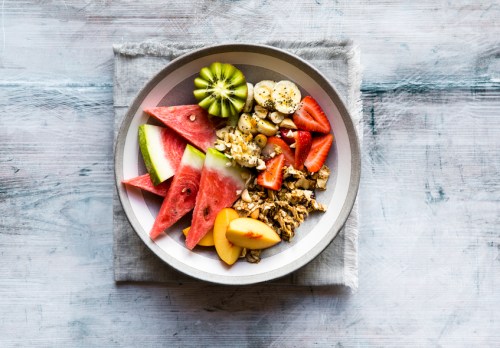Understanding the Difference Between Soluble and Insoluble Fiber Is a Key Part of Eating for Optimal Gut Health
A gastroenterologist explains the difference between soluble and insoluble fiber, what each is good for, and the best sources of both.

When it comes to nutrients, there tends to be a lot of emphasis on getting enough protein, carbohydrates, and healthy fats, including omega-3s, and for good reason: They are the building blocks of your body. For optimal functioning, however, you need to make sure you’re consuming enough fiber as well, since it plays an important role in gut health, heart health, and helping your body eliminate waste. (So just a few necessary tasks, NBD.)
Experts in This Article
gastroenterologist and medical director at Salvo Health
What you may be surprised to learn, though, is that there’s not one but two types of fiber you should be eating regularly: soluble and insoluble. If this is news to you, no worries. The difference between soluble and insoluble fiber is easy to remember, and it’s super simple to mix them both into your diet.
The difference between soluble and insoluble fiber
As the name suggests, soluble fiber dissolves in water and forms a gel-like substance as it makes its way through the intestines, explains Max Pitman, MD, gastroenterologist and medical director at Salvo Health, a virtual health clinic focusing on specialty care for chronic conditions. “This gel-like substance slows down digestion, which can be a good thing, because it can make you feel more energized and satisfied after eating and help slow sugar absorption, thus reducing glucose spikes after meals,” Dr. Pitman says. “Insoluble fiber does not dissolve in water and can actually speed up digestion.”
A balanced diet should have plenty of soluble and insoluble fiber. “All fiber is not fully digested or absorbed by humans, typically passing through the digestive without breaking down and serving many helpful functions as it passes through,” Dr. Pitman says. “Both types of fiber, especially when eaten in combination, host a number of health benefits including stabilizing blood sugar, promoting digestive regularity, reducing cholesterol, and even lowering your risk of developing heart disease and many types of cancer as well,” Dr. Pitman says.
Given how it functions in the gastrointestinal tract, soluble fiber is good for regulating bowel movements—“it can be helpful for both diarrhea and constipation,” Dr. Pitman says—and can be very helpful for IBS symptoms like bloating and abdominal discomfort, he adds. Meanwhile, insoluble fiber, because it speeds up digestion, is more helpful for constipation, according to Dr. Pitman.
How much insoluble and soluble fiber you should eat per day
Overall, adults should consume 28 grams of fiber per day, according to the Food and Drug Administration (FDA), but Dr. Pitman says that should be a baseline. “In my opinion, these are great goals, but eating more than that is beneficial as long as you increase dietary fiber slowly to avoid excessive gas or indigestion,” Dr. Pitman says. He adds that this is especially true for anyone with chronic gut issues (such as IBS or SIBO), as these conditions can cause some to experience abdominal discomfort or bloating upping their fiber intake. “These symptoms are usually temporary,” he says, “so it’s important to increase fiber amounts slowly and let your body adjust little by little. A medical provider or nutritionist can help you find the right high fiber foods that won’t cause too many unpleasant symptoms.” (The FDA doesn’t currently breakdown its daily fiber intake recommendation into soluble and insoluble fiber, FYI.)
Best sources of soluble and insoluble fiber
In general, fiber is a part of all plant foods and often contained in the walls between plant cells, according to Dr. Pitman. But the best sources of soluble fiber include oats (oatmeal and oat bran), fruits, such as apples and pears (with the skin on) and berries, beans, and legumes (lentils, black beans, chickpeas), as well as most nuts and seeds.
Insoluble fiber, on the other hand, can be found in whole wheat and wheat bran, other whole grains like brown rice and barley, and many vegetables including celery, carrots, zucchini, plus leafy greens such as spinach or lettuce.
While dietary fiber from whole foods is the best way to increase fiber intake, according to Dr. Pitman, he says fiber supplements such as psyllium or flax may be very helpful as well—especially if you are having trouble incorporating enough dietary fiber into your daily routine. Just be sure to speak with a healthcare professional, such as a gastroenterologist, before introducing any new supplements into your routine.
Oh hi! You look like someone who loves free workouts, discounts for cutting-edge wellness brands, and exclusive Well+Good content. Sign up for Well+, our online community of wellness insiders, and unlock your rewards instantly.
Sign Up for Our Daily Newsletter
Get all the latest in wellness, trends, food, fitness, beauty, and more delivered right to your inbox.
Got it, you've been added to our email list.










